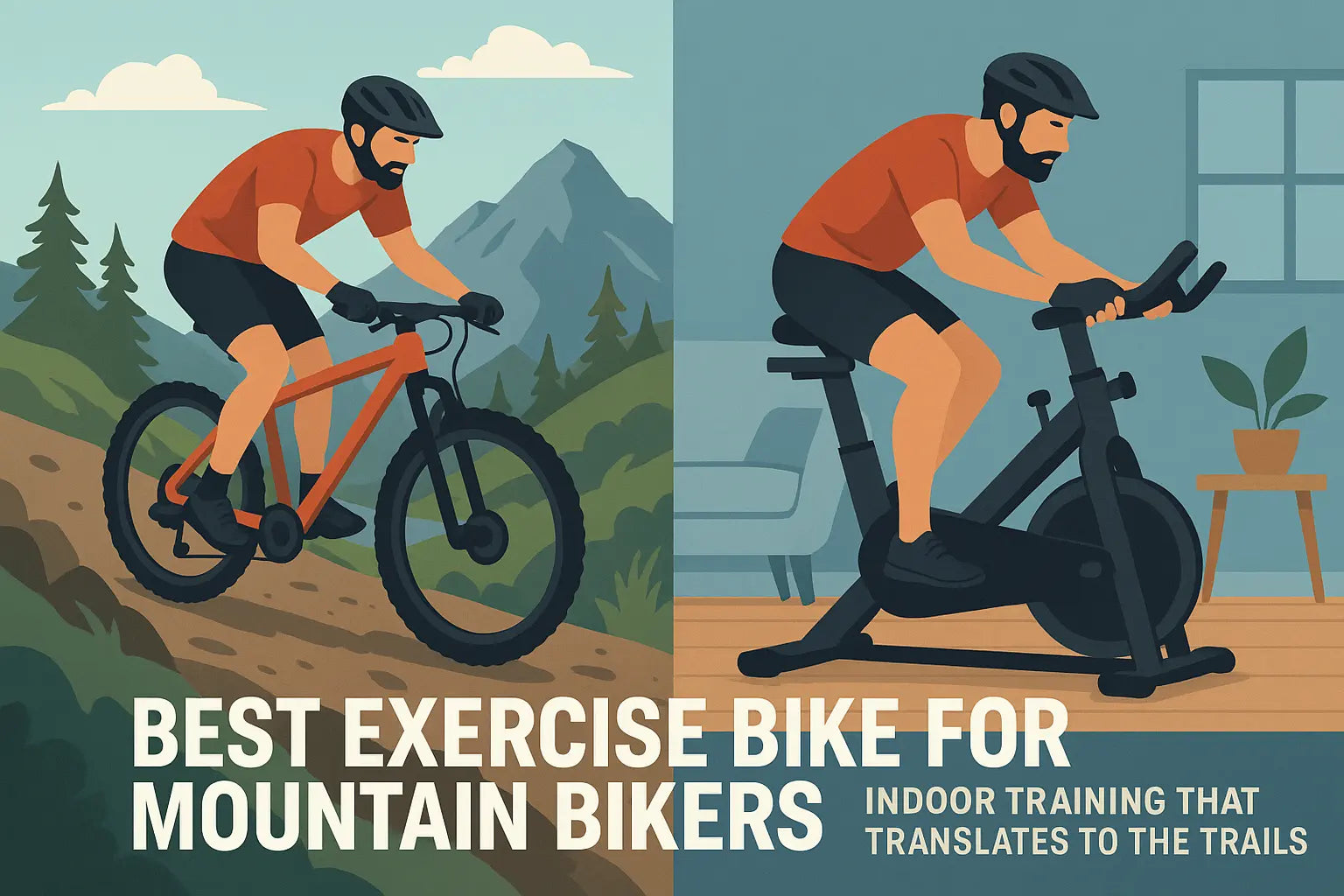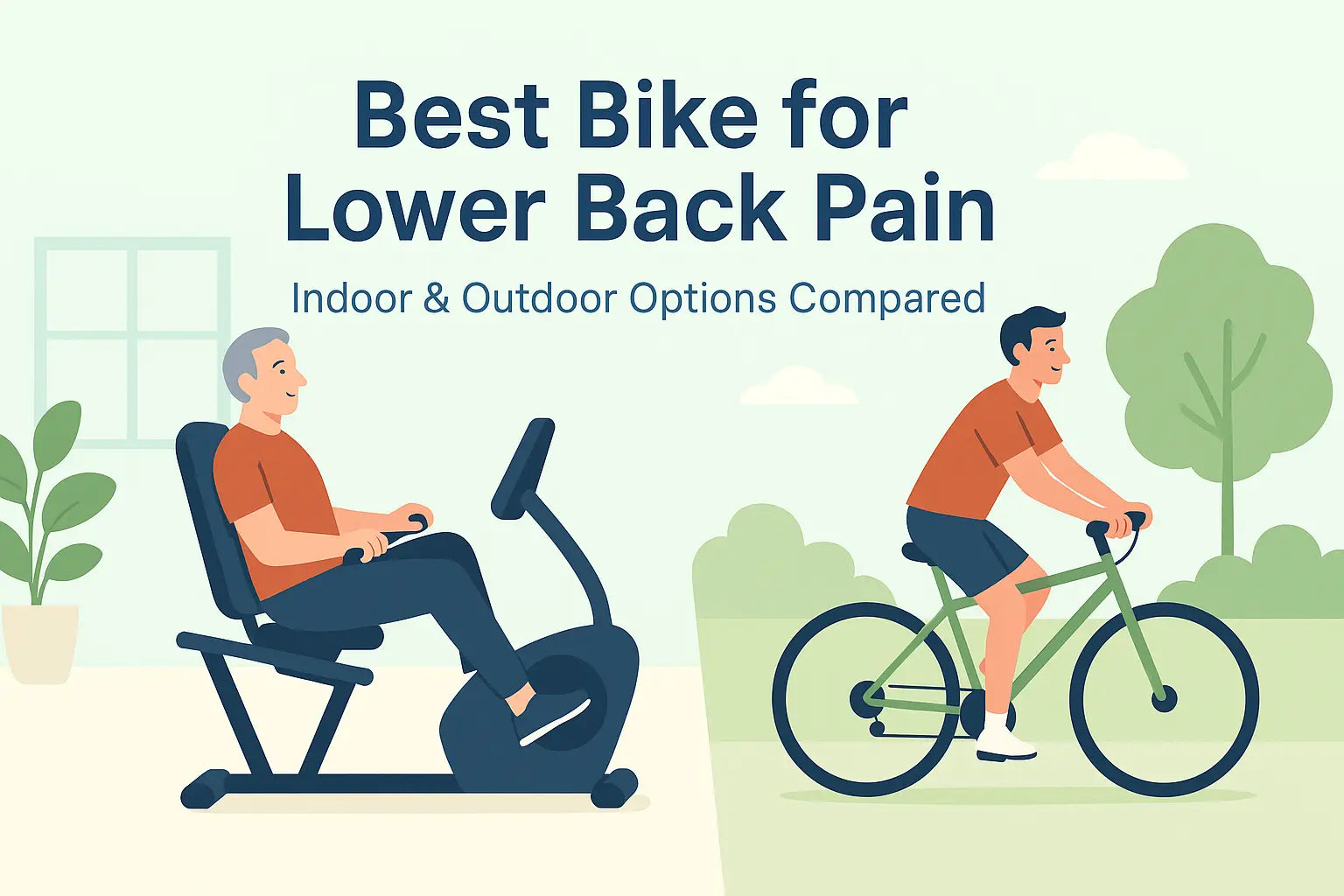Lower back pain is one of the most common health complaints today, affecting office workers, athletes, and everyday individuals alike. Many cyclists experience back discomfort due to poor bike fit or improper riding habits. Whether caused by poor posture, sedentary lifestyles, or age-related issues, it can interfere with daily life and limit the ability to exercise. According to the Cleveland Clinic [1], cycling is classified as a low-impact aerobic exercise that improves cardiovascular health while reducing strain on the joints. However, not all bikes are created equal when it comes to supporting the spine. Some designs place significant stress on the lower back, while others provide ergonomic support that helps relieve discomfort. The Cleveland Clinic [2] also notes that the proper bike fit and setup can help alleviate pain by promoting good posture and reducing strain during cycling.
In this article, we will compare the best bikes for lower back pain, covering both indoor exercise bikes and outdoor bicycles. Understanding bike fit and choosing the right biking style can make a significant difference for those with back pain. By examining the pros and cons of each type, you’ll be able to choose the right option for your needs, whether you prefer training in the comfort of your home or riding outdoors in fresh air.
Why Cycling Can Help With Lower Back Pain
Cycling, when done correctly, offers several benefits for those dealing with back discomfort:
-
Low-impact movement: Unlike running or jumping, bicycling is gentle on the joints and spine.
-
Strengthens supporting muscles: Pedaling activates the glutes, hamstrings, core muscles, and back muscles, which can help stabilize the lower back. (Medicina 2024 [3])
-
Improved blood circulation: Enhanced blood circulation reduces stiffness and promotes healing in affected areas.
-
Encourages movement without strain: Regular bicycling builds endurance without the heavy impact of weightlifting or high-intensity sports.
That said, the type of bike you use—and how you use it—can make all the difference. Let’s look at the options in detail.
Indoor Exercise Bikes
Outdoor Bicycles
Indoor Exercise Bikes
Indoor exercise bikes are a convenient way to work out year-round. But for those with lower back pain, choosing the right type is crucial. Different bike types and riding styles offer various positions, which can significantly impact back comfort.
Recumbent Exercise Bike
Recumbent Exercise bikes are often considered the best choice for lower back pain. They feature a large, reclined seat with a supportive backrest, allowing riders to pedal in a semi-reclined position. This reclining position supports proper positioning for the rider, promoting an ergonomic posture that reduces back strain and improves comfort. This reduces spinal pressure and helps maintain a neutral posture.
Benefits of Recumbent Exercise Bikes for Back Pain:
-
Full back support to minimize spinal strain
-
Comfortable, wide seating that reduces hip and tailbone discomfort
-
Semi-reclined posture that lowers pressure on lumbar discs
-
Stable design, making it ideal for seniors and rehabilitation
-
Weight is distributed more evenly, resulting in less pressure and less strain on the back, which allows for a pain free ride even during extended periods of exercise
For people dealing with chronic lower back pain, recumbent exercise bikes provide a safe, sustainable workout option. We’ve also created a detailed guide on the Best Recumbent Exercise Bike to help you choose the right one.
Upright Bike
Upright bikes resemble traditional bicycles, requiring the rider to lean forward slightly into a forward leaning position. To minimize discomfort and prevent back pain, it is important to maintain good posture, including a slight bend in the elbows and a neutral spine. While they are compact and great for cardio workouts, they can put pressure on the lower back during long sessions.
Pros:
-
Small footprint, suitable for limited space
-
Provides a traditional cycling feel
-
Effective calorie-burning option
Cons:
-
Minimal back support
-
Extended use may aggravate back issues
For those with mild or occasional discomfort, upright bikes may still be manageable—especially if the seat and handlebars are properly adjusted.
Spin Bike
Spin bikes are designed for high-intensity training and simulate the feel of road cycling. Riders often lean forward aggressively (leaning forward), similar to a racing posture. This makes spin bikes less suitable for individuals with back pain.
Why Spin Bikes May Not Be Ideal for Back Pain:
-
Aggressive forward-leaning posture stresses the lower back
-
Hard, narrow seats increase discomfort
-
Best suited for healthy individuals seeking intense workouts
Outdoor Bicycles
If you prefer to take your workouts outside, the type of bicycle you choose is equally important for managing back pain. Selecting the right bike for back comfort depends on the bike's design—such as its geometry and frame size—and how well it matches your body type.
Road Bike
Road bikes are built for speed, with drop handlebars that encourage a low, forward-leaning posture. Unfortunately, this position places significant stress on the lumbar spine.
Pros:
-
Lightweight and efficient for fast rides
-
Ideal for competitive cycling and endurance training
Cons:
-
Deep forward lean stresses the back and neck
-
Aggressive posture can contribute to knee pain and neck pain, especially during long rides
-
Hard saddles and stiff frames transmit road vibrations
For individuals with existing back issues, road bikes are usually not recommended.
Mountain Bike
Mountain bikes feature a more upright posture compared to road bikes. They also have wider tires and suspension systems that help absorb shocks, reducing the impact on the lower back.
Advantages:
-
Upright riding position reduces spinal strain
-
Suspension absorbs bumps and vibrations
-
Suitable for casual riders and mixed terrain
-
Can be adapted for off road biking by using bigger tires or larger wheels, which provide improved stability and comfort on rough terrain
Potential Drawbacks:
-
Off-road bumps may still cause strain during long rides
-
Heavier frames require more effort on flat roads
Touring / Hybrid Bike
Touring and hybrid bikes combine elements of road and mountain bikes, prioritizing comfort and endurance. They encourage a more upright posture, which makes them suitable for long-distance rides without stressing the lower back.
Why Touring/Hybrid Bikes Are Good for Back Pain:
-
Upright handlebars for a comfortable posture
-
Relatively high handlebars and high handlebars promote a more upright position, reducing strain on the back and neck
-
Wider saddles and ergonomic grips
-
Designed for long-distance comfort
These are an excellent option for riders who want to enjoy outdoor cycling without sacrificing back health.
Recumbent Bike (Outdoor Version)
Just like their indoor counterparts, recumbent outdoor bicycles feature reclined seating and full back support. They are widely regarded as the best outdoor option for lower back pain.
Benefits:
-
Ergonomic reclined position with lumbar support
-
Adjustable positions for seating and handlebars, providing support for the back and maintaining proper spinal alignment during long rides
-
Reduced spinal pressure compared to upright bikes
-
Smooth, comfortable ride for long distances
Limitations:
-
Bulky and less maneuverable in urban traffic
-
Higher cost compared to standard bicycles
Indoor vs Outdoor: A Comparison
To better understand the options, here’s a side-by-side comparison:
|
Bike Type |
Riding Posture |
Back Support |
Best For |
Back Pain Friendliness |
|---|---|---|---|---|
|
Recumbent Exercise Bike (Indoor) |
Reclined |
Full backrest |
Rehab, seniors, chronic pain |
⭐⭐⭐⭐⭐ |
|
Upright Exercise Bike (Indoor) |
Slight forward lean |
Minimal |
Casual cardio, small spaces |
⭐⭐ |
|
Spin Bike (Indoor) |
Aggressive forward lean |
None |
Intense workouts, healthy riders |
⭐ |
|
Road Bike (Outdoor) |
Deep forward lean |
None |
Speed, competition |
⭐ |
|
Mountain Bike (Outdoor) |
Semi-upright |
Partial (suspension helps) |
Off-road, casual rides |
⭐⭐⭐ |
|
Touring/Hybrid Bike (Outdoor) |
Upright |
Moderate |
Long-distance, casual riders |
⭐⭐⭐⭐ |
|
Recumbent Bike (Outdoor) |
Reclined |
Full back support |
Chronic pain, endurance comfort |
⭐⭐⭐⭐⭐ |
In addition to the bikes listed above, comfort cruiser bikes, cruiser bikes, comfort cruisers, and adult tricycles are also excellent options for those seeking extra comfort and stability for back pain. These styles offer an upright, ergonomic riding position and enhanced stability, making them ideal for individuals with back pain, balance issues, or mobility concerns.
How to Choose the Best Bike for Lower Back Pain
When selecting the right bike, consider the following:
-
Posture: Opt for bikes that allow an upright or reclined position, not aggressive forward leans.
-
Seat Design: Wide, cushioned seats with gel or foam materials are preferable to narrow saddles, as they provide enhanced support for your sit bones and improve overall cycling comfort.
-
Adjustability: Look for adjustable handlebars, saddle height, and back support. Proper saddle height is crucial for comfort and to prevent back pain.
-
Shock Absorption: Suspension systems and wider tires reduce road vibrations.
-
Extra Stability: Consider bikes that offer extra stability, such as tandem bikes designed for two riders. These provide better balance and mutual support, which can be especially helpful for those with back issues and can further enhance cycling comfort.
-
Personal Goals: Are you cycling for fitness, rehab, or leisure? Match the bike to your purpose.
Tips for Riding with Lower Back Pain
No matter what bike you choose, technique and setup matter. Here are some tips:
-
Keep your back straight and avoid hunching forward.
-
Adjust your seat height so your knees are slightly bent at the bottom of each pedal stroke.
-
Change your positions regularly during long rides to prevent back pains and back strain.
-
Ensure your legs are properly positioned to reduce strain and pains during extended periods of cycling.
-
Use padded shorts or a seat cushion for extra comfort.
-
Strengthen your core with complementary exercises to support spinal health.
-
Listen to your body and take breaks as needed to avoid discomfort.
-
Start with short sessions and gradually increase duration.
Source: The National Library of Medicine [4] suggests that posture adjustments and seat ergonomics can significantly reduce spinal stress for cyclists with back pain.
Conclusion
Lower back pain doesn’t have to keep you from enjoying cycling. The key is choosing the right bike for your needs. The best exercise bike for lower back pain is a recumbent exercise bike, because its reclined seat and back support reduce pressure on the spine and promote proper posture. For those who prefer outdoor adventures but want to protect their spine, recumbent bikes or touring bikes strike an excellent balance between comfort and performance. Meanwhile, upright and spin bikes, as well as road bikes, may aggravate back pain if used extensively.
By understanding your body’s needs and making smart equipment choices, you can continue to enjoy the many benefits of cycling without worsening your back pain. Whether you ride indoors or outdoors, the right bike can transform cycling into a safe, effective, and enjoyable part of your wellness routine.
Reference
- Cleveland Clinic. (2023, March 9). Aerobic exercise: Top 10 reasons to get physical. Cleveland Clinic. https://my.clevelandclinic.org/health/articles/7050-aerobic-exercise
- Cleveland Clinic. (2022, October 18). Posture: What it is & why it matters. Cleveland Clinic. https://my.clevelandclinic.org/health/articles/posture
- Ahn, S.-E., Lee, M.-Y., & Lee, B.-H. (2024). Effects of gluteal muscle strengthening exercise-based core stabilization training on pain and quality of life in patients with chronic low back pain. Medicina, 60(6), 849. https://doi.org/10.3390/medicina60060849
- Salai, M., Brosh, T., Blankstein, A., Oran, A., & Chechik, A. (1999). Effect of changing the saddle angle on the incidence of low back pain in recreational bicyclists. British journal of sports medicine, 33(6), 398–400. https://doi.org/10.1136/bjsm.33.6.398
Latest Articles







